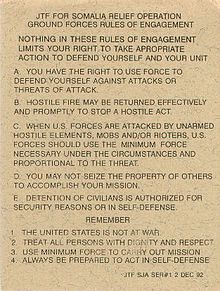Operation Provide Relief
Operation Provide Relief was part of United Nations (UN) endorsed effort called The Unified Task Force (UNITAF) to secure and facilitate humanitarian relief for the people of Somalia, an effort that was assisted by the UN UNOSOM I mission beginning in 1991 in light of a severe famine, initiated and exacerbated by the ongoing Somali civil war.
It was initiated and spearheaded by the United States of America and other Western nations that committed troops to conduct the operation. However most of the food was looted shortly upon the landing of these planes. This made the operation a failure and the UN therefore asked its members for assistance, leading to Operation Restore Hope.
Somalian famine
In January 1991, the leader of Somalia, Mohammed Siad Barre, was overthrown by a coalition of opposing clans called the United Somalia Congress. In September 1991, severe fighting broke out in Mogadishu which continued in the following months and spread throughout the country with over 20,000 people killed or injured by the end of the year. These wars led to the destruction of the agriculture of Somalia which in turn led to starvation in large parts of Somalia. The international community began to send food supplies to halt the starvation. However vast amounts of food were hijacked and brought to local clan leaders. The food was routinely exchanged with other countries for weapons by them. An estimated 80% of the food was stolen. These factors led to even more starvation of which an estimated 300,000 people died and another 1.5 million suffering between 1991 and 1992. In July 1992, after a ceasefire between the opposing clan factions, the United Nations (UN) sent 50 military observers to hold sight on the distribution of the food.
Operation Provide Relief


Operation Provide Relief began in August 1992, when the White House announced US military transports would support the multinational UN relief effort in Somalia. Ten C-130s and 400 people deployed to Moi International Airport, Mombasa, Kenya, during Operation Provide Relief, airlifting aid to remote areas in Somalia to reduce reliance on truck convoys. One member of the 86th Supply Squadron deployed with the ground support contingent, USAFE's only contribution to the operation.
The Air Force C-130s delivered 48,000 tons of food and medical supplies in six months to international humanitarian organizations, trying to help the over three million starving people in the country. When this proved inadequate to stop the massive death and displacement of Somali people (500,000 dead; 1.5 million refugees or displaced), the U.S. in December 1992 launched a major coalition operation, Operation Restore Hope to assist and protect humanitarian activities.
That operation was eventually successful in stopping the famine and saving an estimated 200,000 lives, as well as de-escalating the high-intensity civil war into low-level, local skirmishes, but after a long and protracted effort and eventual pull-out of US forces following the Battle of Mogadishu.
The operation has been criticized for expanding beyond its original boundaries ("mission creep"). The Refugee Policy Group (NGO in Washington) in November 1994 "Lives Lost, Lives Saved: Excess Mortality and the Impact of Health Interventions in the Somalia Emergency" believes that any assessment of the success of Operation Provide Relief is "so fraught with methodological problems that it is rarely attempted."
As such, they offer a conservative estimate that about 100,000 lives were saved as a result of outside assistance, about 10,000 after the United States as part of Operation Provide Relief. They also conclude that some 202,000 to 238,000 lives were lost to famine or famine related disease.
Further reading
- Allard, Colonel Kenneth, Somalia Operations: Lessons Learned, National Defense University Press (1995).
See also
- Operation Restore Hope
- Operation Deliverance, the concurrent Canadian mission
